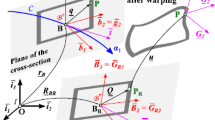Abstract
This paper describes an extremely simple, and yet accurate technique, based on electric analogy, for determining torsion and flexure functions of beams of uniform section, acted upon by terminal loads. Equations governing the torsion and flexure of such beams have been expressed to state the problem as a Neumann-type boundary-value problem; thus, the problem reduces to finding a function (or functions), which is harmonic within the cross section of the beam, and whose normal derivatives at the boundary of the section are prescribed.
Prescribed current densities are introduced at the boundary, and consequent voltages are obtained as the analogue of required functions. Instrumentation is very simple and, once what has been described here as the “influence matrix” of voltages is obtained, both torsion and flexure functions can be obtained simply by multiplying the “influence matrix” by vectors of appropriate normal derivatives at the boundary. None of the usual drawbacks of membrane analogy arise here. Use and accuracy of the technique have been demonstrated by a number of examples.
Similar content being viewed by others
Abbreviations
- a :
-
a linear dimension
- e :
-
Poisson's ratio
- F x, Fy :
-
forces parallel to thex andy axes, respectively
- G :
-
modulus of rigidity
- i :
-
current density
- {I}:
-
vector of current densities
- J y, Jx :
-
moment of area about they andx axes, respectively
- K :
-
a constant
- L :
-
length of beam
- N :
-
total number of boundary points
- r :
-
specific resistance of medium
- s zx, etc.:
-
shear stresses
- [S D]:
-
a diagonal matrix
- t :
-
angle of twist per unit length of beam
- V :
-
voltage
- [V']:
-
influence matrix of voltages
- x,y,z :
-
Cartesian coordinates
- ∇2 :
-
the Laplacian operator
- ψ, ϕ, ϕ1 and ϕ2 :
-
harmonic functions
References
Sokolnikoff, I. S., “Mathematical Theory of Elasticity,”2nd. ed., McGraw-Hill Book Co., Inc., New York, N. Y. (1956).
Timoshenko, S. and Goodier, J. N., “Theory of Elasticity,” McGraw-Hill Book Co., 336–342 (1951).
Redshaw, S. C., “A Resistance Network of Novel Construction for Solving Certain Problems in Elasticity,” International Analogy Computation Meeting, 406–409 (Sept. 1955).
Author information
Authors and Affiliations
Rights and permissions
About this article
Cite this article
Nath, B. An analogue technique for determining torsion and flexure functions of uniform beams. Experimental Mechanics 9, 117–122 (1969). https://doi.org/10.1007/BF02327697
Issue Date:
DOI: https://doi.org/10.1007/BF02327697




